There is a large number of people and sources claiming today is Turkey Day, and so I got an early start and went out to the nearby pond to chase pics, hoping to expand my turkey images, which are fairly sparse. Alas, none of these sources seems to have the faintest clue, because there wasn’t a turkey to be seen anywhere, despite the wide variety of other avians lurking about. Never trust the media.
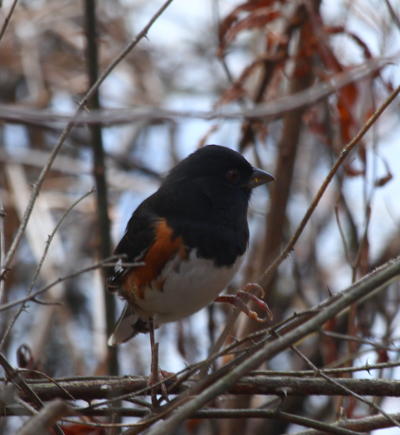 Second, at some point in the not-too-distant past I remarked about not being much of a bird photographer, so it seems only fitting that this year I’ve done a indisputable shitload of bird photos (notice that I never said they were good bird photos.) So yeah, never trust me either. Except for not missing any regularly-scheduled posts – that I can do.
Second, at some point in the not-too-distant past I remarked about not being much of a bird photographer, so it seems only fitting that this year I’ve done a indisputable shitload of bird photos (notice that I never said they were good bird photos.) So yeah, never trust me either. Except for not missing any regularly-scheduled posts – that I can do.
But yesterday’s rains and fairly decent temperatures this partly-sunny morning meant that the bird activity was prodigious, and I heard at least twice as many species as I photographed; some of them were just being difficult. Among them, a staple this time of year, was this rufous-sided towhee, or it seems eastern towhee is now preferred, which is a shame because there’s, like, an eastern everything, but how many rufous-sided species do you know of? Regardless, the scientific name hasn’t changed, and that’s Pipilo erythrophthalmus. Yes, that’s pretty distinctive too, but it doesn’t roll off the tongue as well – in fact it gets tangled up in there and makes you inadvertently spit when saying it. “Towhee” actually comes from the sound the bird makes, the easiest way to know they’re around since they tend to forage in the brush and foliage, but who knows where “erythrophthalmus” comes from? If it made that sound people would probably stay locked indoors more.
Almost as secretive, today anyway, were the northern mockingbirds (Mimus polyglottos,) which first prompted my awareness of them by noisily ripping up the pinoak trees for their acorns.
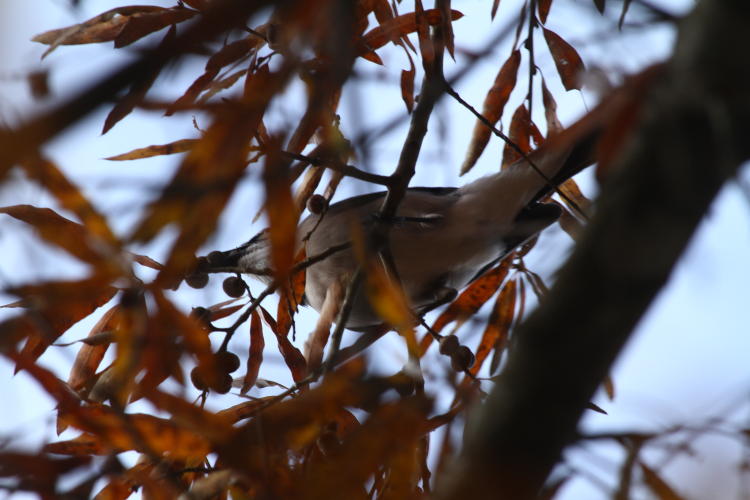
Out near the ends of the branches, the leaves tended to be thick enough to obscure the birds unless I looked hard, and getting a nice photo of one was proving to be difficult. They were also being pretty territorial, chasing off the cardinals that were attempting to consume the same food, which was the only time either of them seemed to be vocalizing at all, curious because there were certainly enough other birds making a racket this morning.
After chasing off a cardinal, one of the mockingbirds paused long enough to give me a stalker’s view.
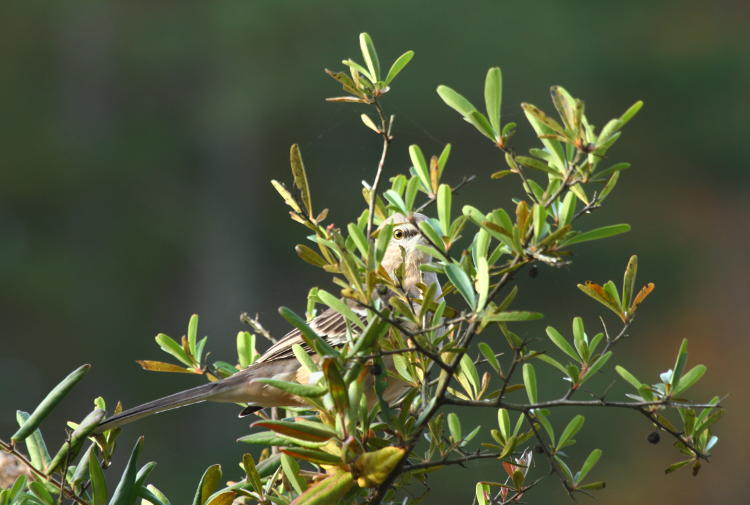
It took a few attempts to get those olive eyes to appear between the leaves, and be sharp enough to keep, but then soon afterward the same bird flew down to a mailbox to pose nicely against the fallen leaves on the lawn.

The semi-resident Canada geese (Branta canadensis) were of course on hand, and believe it or not, we have a decent sampling of fall colors right now – more on that in a following post. So I was endeavoring to do what I could to add some zing into the frame, by choosing my vantage point carefully and using the reflections. Nothing elaborate, but better than the original view that I had as I approached.
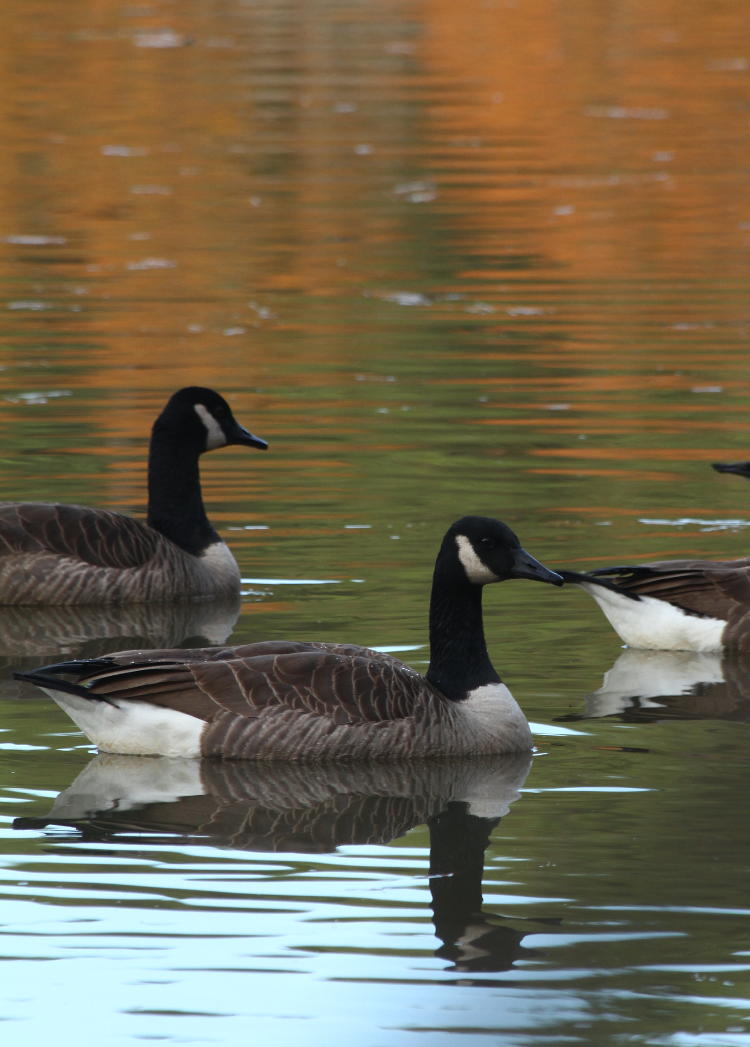
I have enough photos of Canada geese, but hey, nothing else was posing so cooperatively; I found out yesterday that there seems to be a species of grebe hanging out at the pond now, but so far it has remained out of decent photographic conditions. However, someone else down there provided, with some reluctance, enough poses to flesh out the post a bit more.

I was lucky enough to spot this great blue heron (Ardea herodias, and the only “great blue” anything that I know of,) before I got too close and spooked in into flight, so with some slow and careful approaches, I could again make use of the tree colors in the water, for a bit anyway.
[Edit: I lied, as I discovered while adding the tags to this post. There is also a great blue skimmer, a species of dragonfly, and I must have been aware of this because it’s a tag that’s been used before.]
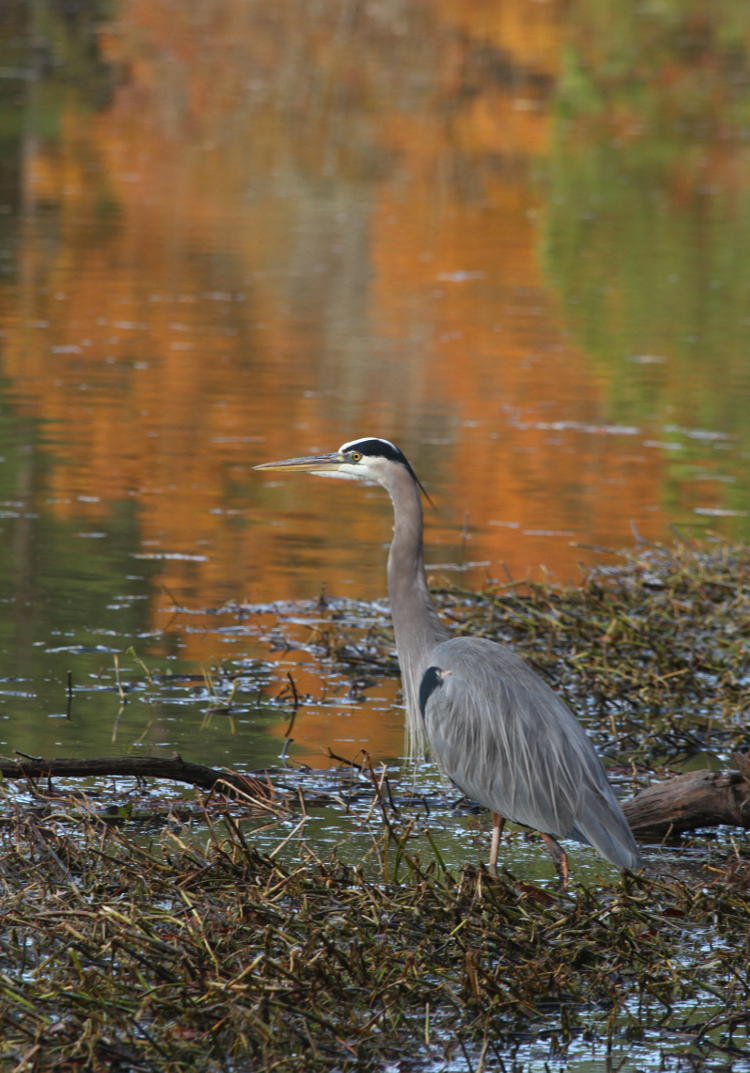
The heron was pretty cool until I crouched to change my angle, and it figured this looked too much like a predator getting ready to spring, is my guess. It flew off towards the other end of the pond, landing in the shallows further along my intended path. Fine; we’d just have to see if it remained put as I worked onward.
It was actually more cooperative than any heron at the pond so far this year.
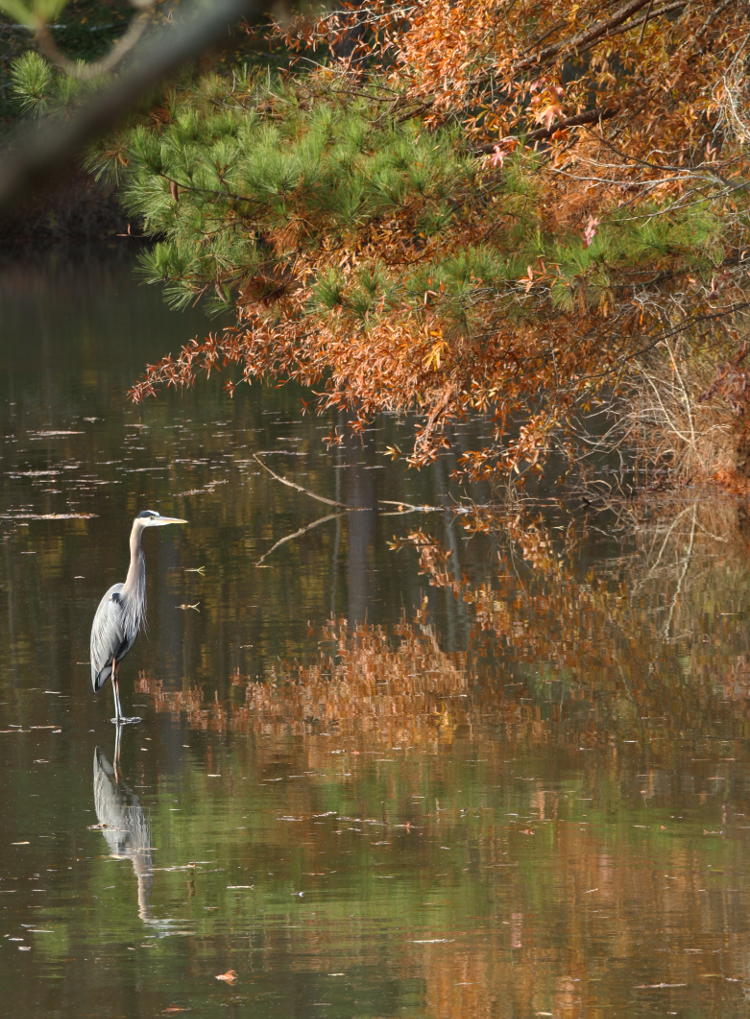
The colors here weren’t ideal, but still enough to make it clear what time of year it was, anyway.
Herons are funny. Lots of people walk their dogs around the pond, and there are more than a few spots where the dogs can have immediate access to the water, so the herons have every reason to be spooky, yet they tend to be more mellow than, for instance, central New York where the threats had to have been much less immediate. At the same time, I’ve seen the same species in areas of Florida where you could almost walk right up to them, so what, exactly, constitutes a threat to them remains to be seen. Today, at least, this one was less spooky than I often see around the pond, but not complacent either.
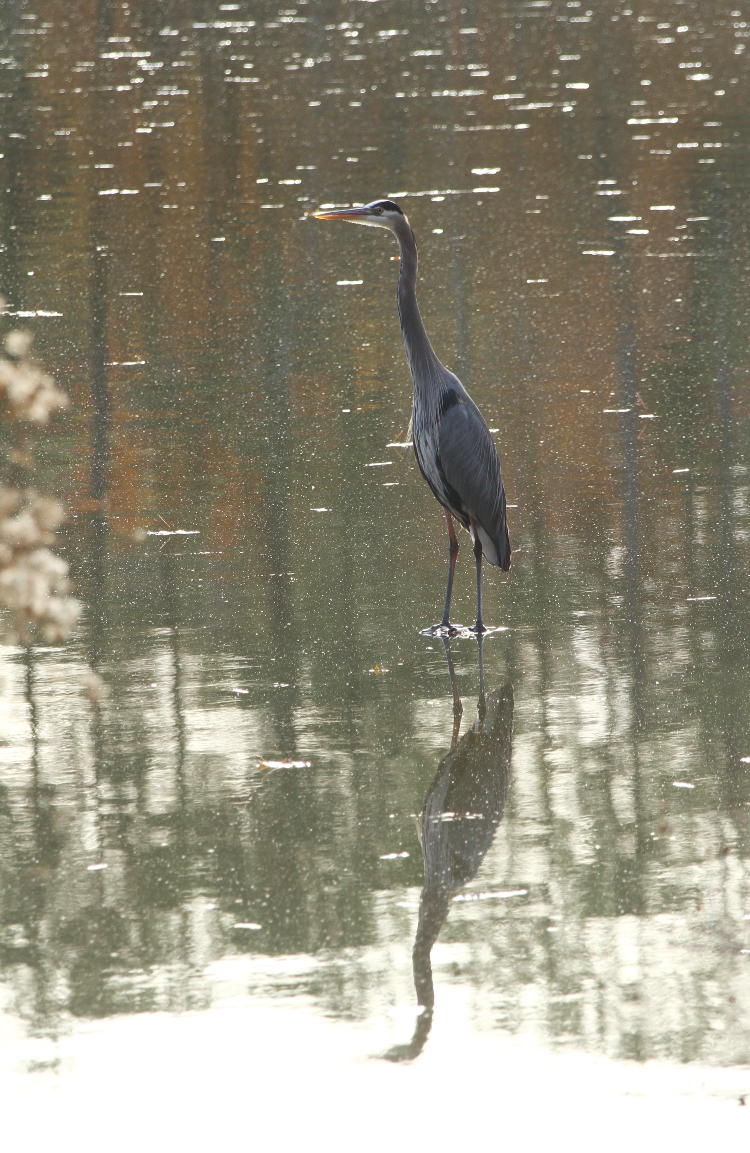
I was able to circle around this one to view it from the opposite side, the bank that supports those trees in the previous photo, but then it flew off without any clear ‘threat’ from me.
By the way, I’d noticed on my previous visit that the rains had driven the pond level high enough to submerge the old dock pilings at this end, but the heron demonstrated just how shallow the tops were under the surface, since it’s way too far out into the water to be at typical wading depth. I couldn’t see them at all, but the bird knew where they were.
When it flew off, it headed back towards the end of the pond we’d both started from, and I could see from its altitude that it was likely heading for a tree perch, so I dismissed it and started watching for other subjects. In a few moments, however, the heron reappeared out over the water heading in the opposite direction again, passing me to take a perch in some pines on a small island. I had no decent view even though I could see roughly where it was from the landing behavior, so I moved on slowly.
I’ll take this opportunity to mention that, for several minutes as I worked my way along, I could hear a belted kingfisher sounding off repeatedly towards the far end, and was plotting it aurally. Kingfishers are a target species of mine, because I have yet to get any images of them that I’m pleased with; they’re both hyperactive and spooky, and most times I only become aware of their presence when I’ve scared them from their perch and sent them, chattering excitedly, well away from me. So as I ambled on, I kept listening, and steering in its direction. Also while watching for the heron.
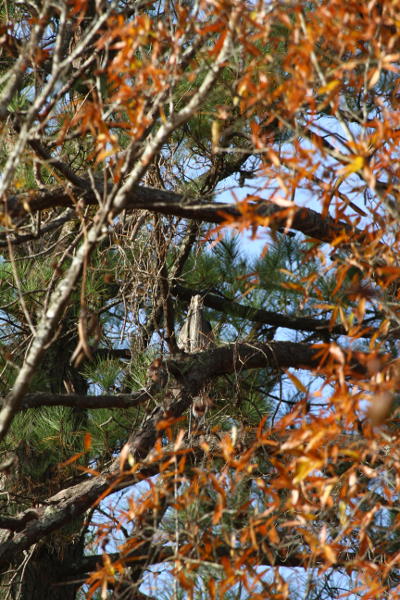 As I began getting a clearer view in that general direction, I started searching for the great blue again. If you’ve never tried it, tracking birds in this manner goes like this: you may get a good idea of where the bird landed, but it’s obscured in some way by intervening foliage, so you change position to try and find a gap to see through. This can change perspective and angle, and very often introduces new foliage to block your view, but sometimes requires a significant difference in direction. You may have been pretty sure that the bird was along a particular line of sight, but as you move, you have to try and triangulate when you never knew for sure where along that line the bird was in the first place. The result is searching hard for something that you know is in a particular vicinity, but not exactly sure where, and not even sure if you can get a clear view from your new positions. And it doesn’t help that the bird may see you coming and decide to vacate its position, which you may or may not be able to witness as it occurs.
As I began getting a clearer view in that general direction, I started searching for the great blue again. If you’ve never tried it, tracking birds in this manner goes like this: you may get a good idea of where the bird landed, but it’s obscured in some way by intervening foliage, so you change position to try and find a gap to see through. This can change perspective and angle, and very often introduces new foliage to block your view, but sometimes requires a significant difference in direction. You may have been pretty sure that the bird was along a particular line of sight, but as you move, you have to try and triangulate when you never knew for sure where along that line the bird was in the first place. The result is searching hard for something that you know is in a particular vicinity, but not exactly sure where, and not even sure if you can get a clear view from your new positions. And it doesn’t help that the bird may see you coming and decide to vacate its position, which you may or may not be able to witness as it occurs.
As I got to a nice gap in the trees closest to me, I was more under the heron’s landing spot, and a good sixty or more degrees off the original angle; I saw something, and I suspected it was the heron, but couldn’t be sure even with the 100-300 lens. The image at right is full-frame, and about what I could discern in the viewfinder. No telltale curve of the neck, no beak, no legs, so was it the heron, or a stump? Was I looking up under its tail? I really just fired off a few frames to do what I’m about to show you, which is to magnify and crop the image to make out details that were not visible at the time.

Yeah, I was right this time, but unaware that the heron was now keeping a sharp eye on me, tired of my slow-motion shenanigans – you can just see the beak extending straight up from the top of that ‘stump,’ and the eyes making their bare appearance past the intervening twigs.
About this time, the kingfisher broke from cover very close to me and flew around in a broad curve, and this was to be the pattern for the next few minutes. I at least had the advantage that it simply couldn’t shut its beak for twenty seconds at a time, something that I’ve never witnessed before. Usually they only make noise like that when they’ve been spooked from cover, but I’ve noticed it just when flying to new perches, so it seems to be a territorial thing too; why, today, it was being so freaking noisy I cannot say, but I’ll put it down to the large number of other birds sounding off on their own, none of them posing either a threat or feeding competition to this particular species, so, you got me.
By the way, while we’ve already seen mockingbirds in this post, kingfishers are the ones that by all rights should possess that name, in my experience, because their raucous chattering call, announcing that they are now eliminating any chance I had of getting a decent view, is just kind of rubbing it in.
But at one point, just when I thought it had left the immediate area and I had turned back to the heron, the kingfisher came straight in towards me and alighted on a branch not very far off, in full view yet directly backlit by the hazy sky. All I was going to get was a silhouette, but I’d take it, especially since its distinctive crest and large beak were highly visible. The trouble was, I was in plain sight too, and had to turn about 90 degrees and raise the camera, which the kingfisher simply didn’t take to, as slow as I tried to accomplish it, and soon flew off. While I figured it would be gone for good, it actually skipped around the area more times, never coming as close, but as I changed position I thought I might get lucky and snag a decent view.
It was not to be, however, just as it wasn’t to be with any of the woodpeckers that I knew were in the immediate vicinity just a tad earlier, as I was rounding on the heron down on the pilings, but never got more than a fleeting glimpse of. Like I said, lots of species around announcing their presence, but not posing in open sight. And no turkeys.
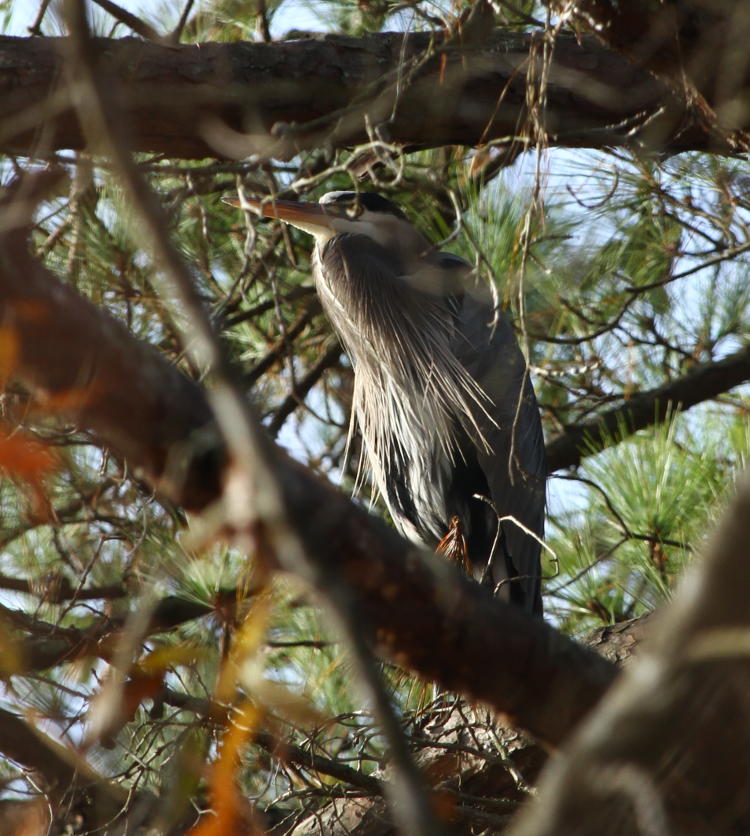
I managed a slightly better perspective on the heron, but not as clear as I would have liked, and within seconds of this frame it took flight again, this time staying well out of my range, but I couldn’t complain (well, if you know me, you know I damn well can and will, but what I’m saying is I shouldn’t.) It wasn’t a bad session for some casual shooting, without even taking the longest lens with me – I’d mostly been after fall colors and the play of sunlight and residual raindrops – and another post will be coming from the same session very shortly. I know this is now posting late in the day on Thanksgiving, despite having started it much earlier – got involved in other things somehow – so I’ll close by saying that I hope everyone had a decent day, didn’t get too embarrassed by their families or anything, and weren’t/aren’t stupid enough to get into that whole shopping-frenzy, runaway-consumerism thing. Cheers!




















































